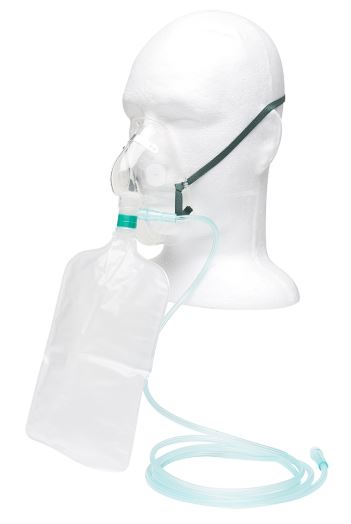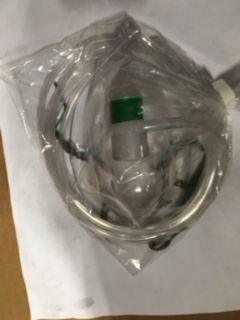OXYGEN FACE MASK, non-rebreathing + tubing, adult
STD
SCTDMASOH1A
Valid Article
Account code:
60210
HS Code:
901890
Last Updated on:
29/06/2025, 23:10:08
Former
Code(s):
-X
Single patient multiple use
A single-use device, also referred to as a disposable device, is intended for use on one patient during a single procedure. It is not intended to be reprocessed (i.e., cleaned and disinfected or sterilized).
CE marking: declaration that the product meets EU standards for health, safety, and environmental protection. The CE marking indicates that the product may be sold freely in any part of the European Economic Area, regardless of its country of origin.
R03010206 - Masks with reservoir
European Medical Device Nomenclature (EMDN) is the nomenclature of use by manufacturers when registering their medical devices in the EUDAMED database. EMDN is characterised by its alphanumeric structure that is established in a seven-level hierarchical tree.
In Europe, medical material that fulfills the definition of a medical device according to the MDR (Medical Device Regulation) is classified into 4 classes
The product is part of at least one Kit.
A kit is a collection of products (medical and/or logistic) that are needed for a certain intervention in emergency. The choice and quantity of the articles reflects the MSF protocols for this specific situation. The use of Kits allows to start an intervention without a detailed evaluation.
OXYGEN FACE MASK, non-rebreathing + tubing
Definition
A flexible, form-shaped device designed to be placed over the nose and mouth to deliver air of high oxygen concentration to a patient's airway. It includes two unidirectional valves, one that closes during inspiration to prevent room air mixing with oxygen in a reservoir bag, and one that closes during exhalation to prevent exhaled respiratory gases from entering the reservoir bag.
It is a soft, flexible mask with an airtight seal against the patient's face. The device includes a headstrap and tubing.
Synonym
High concentration oxygen mask, mask with reservoir bag
Specifications
Quality standards
- EN 13544-2, 2002, +A1 2009 Respiratory therapy equipment. Tubing and connectors
- ISO 15001, 2010, edition 2, (confirmed 2022) Anaesthetic and respiratory equipment — Compatibility with oxygen
Technical specifications
- Mask
- flexible transparent PVC
- exhalation valves with flexible membrane on both sides of the mask, enabling outflow of exhaled air (CO2) and preventing inflow of ambiant air
- nose clip is soft, malleable and adjustable
- elastic fastening strap (latex-free)
- Reservoir bag
- flexible and translucent
- capacity: +/- 750 ml for adult mask, +/- 400 ml for pediatric mask.
- Non-return valve between the mask and the reservoir, preventing exhaled air from entering the reservoir
- Oxygen tube
- PVC low resistance tubing, round shape section, designed for low-flow procedures (0-15l/min)
- Tubing compatibility with standard oxygen connecting tubing, 3-5mm internal diameter and 7-8mm external diameter, and 15/22 mm diameter ventilation tubing.
- length ± 200 cm
- can be disconnected from the mask to allow a quick shift from the oxygen tubing from the mask to the resuscitator
- Non sterile, for single patient use
Packaging & Labelling
Unit packaging
Instructions for use
Some restricted information has been hidden. Sign in
to see this information
Some restricted information has been hidden. Sign in
to see this information
Precautions for Use
- The flow rate of the oxygen source must be twice higher than the patient's minute volume otherwise the reservoir doesn't fill up and the patient cannot breath.
- The oxygen concentrator should have a flow rate of minimum 6-8 litres/min. If greater than 10l/min of flow is required, then two 10l/min oxygen concentrators can be Y-connected to the non-rebreather oxygen mask. Order additional tubing and Y-connector (see related articles).
- Flow rate must be sufficient to keep the bag 1/3 to ½ inflated at all times.
- Avoid kinking and twisting of the reservoir.
- Fit the mask properly on the patient's face not to decrease oxygen concentration.
Some restricted information has been hidden. Sign in
to see this information









![[EEMDCONA008] (ped. distr. Sureflow) EXTRA INTERCONNECTION HOSE, HO151-1](/web/image/product.template/572366/image_256/%5BEEMDCONA008%5D%20%28ped.%20distr.%20Sureflow%29%20EXTRA%20INTERCONNECTION%20HOSE%2C%20HO151-1?unique=63e5f58)
![[SCTDCONN4S-] CONNECTOR, Y-shaped, ext. Ø 4 to 5 mm, autoclavable](/web/image/product.template/571858/image_256/%5BSCTDCONN4S-%5D%20CONNECTOR%2C%20Y-shaped%2C%20ext.%20%C3%98%204%20to%205%20mm%2C%20autoclavable?unique=609ddfa)
![[EEMDCONE12-] CONCENTRATOR O2 (DeVilbiss 1025KS) 10l, 220V + access.](/web/image/product.template/573846/image_256/%5BEEMDCONE12-%5D%20CONCENTRATOR%20O2%20%28DeVilbiss%201025KS%29%2010l%2C%20220V%20%2B%20access.?unique=ae96706)
![[KMEDMHAE131] (mod AMP) ELECTRICAL MEDICAL EQUIPMENT](/web/image/product.template/568880/image_256/%5BKMEDMHAE131%5D%20%28mod%20AMP%29%20ELECTRICAL%20MEDICAL%20EQUIPMENT?unique=271efd5)
![[KMEDMHIS25-] (mod ICU) CATHETERS, TUBES and DRAINS 2021](/web/image/product.template/574344/image_256/%5BKMEDMHIS25-%5D%20%28mod%20ICU%29%20CATHETERS%2C%20TUBES%20and%20DRAINS%202021?unique=4976048)
![[KMEDMHES35-] (mod emergency) CATHETERS, TUBES & DRAINS 2021](/web/image/product.template/574355/image_256/%5BKMEDMHES35-%5D%20%28mod%20emergency%29%20CATHETERS%2C%20TUBES%20%26%20DRAINS%202021?unique=8014f55)
![[KMEDMHOS45-] (mod OT Room) CATHETERS AND DRAINS 2021](/web/image/product.template/574392/image_256/%5BKMEDMHOS45-%5D%20%28mod%20OT%20Room%29%20CATHETERS%20AND%20DRAINS%202021?unique=abfc26b)